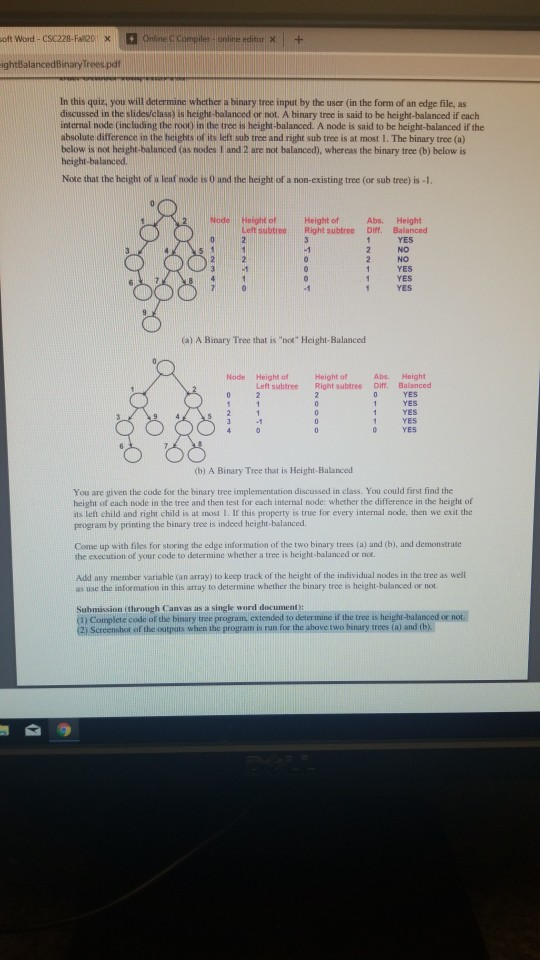Question
#include #include #include #include // for string tokenizer and c-style string processing #include // max function #include // to use abs function using namespace std;

#include
#include
#include
#include
#include
#include
using namespace std;
class BTNode{
private:
int nodeid;
int data;
int levelNum;
BTNode* leftChildPtr;
BTNode* rightChildPtr;
public:
BTNode(){}
void setNodeId(int id){
nodeid = id;
}
int getNodeId(){
return nodeid;
}
void setData(int d){
data = d;
}
int getData(){
return data;
}
void setLevelNum(int level){
levelNum = level;
}
int getLevelNum(){
return levelNum;
}
void setLeftChildPtr(BTNode* ptr){
leftChildPtr = ptr;
}
void setRightChildPtr(BTNode* ptr){
rightChildPtr = ptr;
}
BTNode* getLeftChildPtr(){
return leftChildPtr;
}
BTNode* getRightChildPtr(){
return rightChildPtr;
}
int getLeftChildID(){
if (leftChildPtr == 0)
return -1;
return leftChildPtr->getNodeId();
}
int getRightChildID(){
if (rightChildPtr == 0)
return -1;
return rightChildPtr->getNodeId();
}
};
class BinaryTree{
private:
int numNodes;
BTNode* arrayOfBTNodes;
public:
BinaryTree(int n){
numNodes = n;
arrayOfBTNodes = new BTNode[numNodes];
for (int id = 0; id
arrayOfBTNodes[id].setNodeId(id);
arrayOfBTNodes[id].setLevelNum(-1);
arrayOfBTNodes[id].setLeftChildPtr(0);
arrayOfBTNodes[id].setRightChildPtr(0);
}
}
void setLeftLink(int upstreamNodeID, int
downstreamNodeID){
arrayOfBTNodes[upstreamNodeID].setLeftChildPtr(&arrayOfBTNodes[downs
treamNodeID]);
}
void setRightLink(int upstreamNodeID, int
downstreamNodeID){
arrayOfBTNodes[upstreamNodeID].setRightChildPtr(&arrayOfBTNodes[down
streamNodeID]);
}
void printLeafNodes(){
for (int id = 0; id
if
(arrayOfBTNodes[id].getLeftChildPtr() == 0 &&
arrayOfBTNodes[id].getRightChildPtr() == 0)
cout
}
cout
}
bool isLeafNode(int nodeid){
if (arrayOfBTNodes[nodeid].getLeftChildPtr()
== 0 && arrayOfBTNodes[nodeid].getRightChildPtr() == 0)
return true;
return false;
}
int getNodeHeight(int nodeid){
if (nodeid == -1 || isLeafNode(nodeid) )
return 0;
int leftChildID =
arrayOfBTNodes[nodeid].getLeftChildID(); // -1 if not exist
int rightChildID =
arrayOfBTNodes[nodeid].getRightChildID(); // -1 if not exist
int heightOfLeftChild =
getNodeHeight(leftChildID);
int heightOfRightChild =
getNodeHeight(rightChildID);
return max(heightOfLeftChild,
heightOfRightChild) + 1;
}
int getTreeHeight(){
return getNodeHeight(0);
}
bool checkHeightBalancedTree(){
// Implement this function to determine
whether for each internal node, the absolute difference
// between the height of the left child and
the right child is at most 1. If it is true for each internal ndoe, the
// binary tree is said to be height-balanced.
Even if one internal node is not height-balanced, the
// whole binary tree is considered not
height-balanced.
}
};
int main(){
string filename;
cout
cin >> filename;
int numNodes;
cout
cin >> numNodes;
BinaryTree binaryTree(numNodes);
ifstream fileReader(filename);
if (!fileReader){
cout
return 0;
}
int numCharsPerLine = 10;
char *line = new char[numCharsPerLine];
// '10' is the maximum number of characters per line
fileReader.getline(line, numCharsPerLine, ' ');
// ' ' is the delimiting character to stop reading the line
while (fileReader){
char* cptr = strtok(line, ",: ");
string upstreamNodeToken(cptr);
int upstreamNodeID = stoi(upstreamNodeToken);
cptr = strtok(NULL, ",: ");
int childIndex = 0; // 0 for left child; 1 for right
child
while (cptr != 0){
string downstreamNodeToken(cptr);
int downstreamNodeID =
stoi(downstreamNodeToken);
if (childIndex == 0 && downstreamNodeID != -
1)
binaryTree.setLeftLink(upstreamNodeID,
downstreamNodeID);
if (childIndex == 1 && downstreamNodeID != -
1)
binaryTree.setRightLink(upstreamNodeID,
downstreamNodeID);
cptr = strtok(NULL, ",: ");
childIndex++;
}
fileReader.getline(line, numCharsPerLine, ' ');
}
cout
if (binaryTree.checkHeightBalancedTree())
cout
else
cout
return 0;
}
Can you please uploads screenshots
Onine CCOmpiler-online editor xl + oft Word- CSC228-Fal 201 x ghtBalancedBinary Trees.pdf In this quiz you will determine whether a binary tree input by the user (in the form of an edge file, as discussed in the slides/class) is height-halanced or not. A binary tree is said to be height-balanced if each internal node (including the roo) in the tree is height-balanced. A node is said to be height-balanced if the absolute difference in the heights of its left sub tree and right sub tree is at most 1. The binary tree (a) below is not height-balanced (as nodes 1 and 2 are not balanced), whereas the binary tree (b) below is height-balanced Note that the height of a leaf node is 0 and the height of a non-existing tree (or sub tree) is-1, Node Height oflHeight of Left subtree Right subtree Abs. Height Diff. Balanced YES YES YES YES (a) A Binary Tree that is "nox" Height-Balanced Node Left subtree 2 Height of Height of Abs Height Left subtree Right subtree Dift. Balanced YES YES YES YES (b) A Binary Tree that is Height Balanced You are given the code for the binary tree implementation discussed in class. You could first find the height of each node in the tree and then test for each internal node: whether the difference in the height of its left child and right child is at most I. If this property is true for every internal node, then we exit the program by printing the binary tree is indeed height-balanced Come up with files for storing the edge information of the two binary trees (a) and (b), and demonstrate execution of your code to determine whether a tree is height-balanced or not. Add any member variable (an array) to keep track of the height of the individual nodes in the tree as well as use the information in this array to determine whether the binary tree is height-balanced or nort Submission ( through Canvas as a single word document): (I) Conplete code of tdhe binary tree program, extended to determine if the tree is height-balanced or not (2i Screenshot of the outputs when the program is run for the ahove two binary trees (a) and (bStep by Step Solution
There are 3 Steps involved in it
Step: 1

Get Instant Access to Expert-Tailored Solutions
See step-by-step solutions with expert insights and AI powered tools for academic success
Step: 2

Step: 3

Ace Your Homework with AI
Get the answers you need in no time with our AI-driven, step-by-step assistance
Get Started


